It depends on
I have designed common 2..3-way speakers in 3-4 hours including rigging and setup of measurement gear and speaker, 21-22 measurements per driver and all simulations. Woodwork and assembling of crossover takes much more time.
Very familiar and simple concepts can be designed without listening a second with accurate and complete measurements and good simulator. The result is good and universal but not necessarily the best for particular room (acoustics), locations and listener. Sound of drivers and concept may still have some nuances and properties which all listeners don't like or prefer, though overall design if flawless. That is standard also with commercial products.
Complex, abnormal and unfamiliar designs have much more higher risks, but general understanding of acoustics and experience help controlling resolution spectrum, tonal balance, sound stage etc. Designing may take for a week or two. That is mostly studying of correlation between measurements and subjective impressions.
- complexity and abnormality of the concept
- designing and listening experience from the concept
- accuracy and coverage of the measurements
- competence of the simulator
- selected music (diversity, revealing) for subjective evaluation, if listening and tuning is needed
I have designed common 2..3-way speakers in 3-4 hours including rigging and setup of measurement gear and speaker, 21-22 measurements per driver and all simulations. Woodwork and assembling of crossover takes much more time.
Very familiar and simple concepts can be designed without listening a second with accurate and complete measurements and good simulator. The result is good and universal but not necessarily the best for particular room (acoustics), locations and listener. Sound of drivers and concept may still have some nuances and properties which all listeners don't like or prefer, though overall design if flawless. That is standard also with commercial products.
Complex, abnormal and unfamiliar designs have much more higher risks, but general understanding of acoustics and experience help controlling resolution spectrum, tonal balance, sound stage etc. Designing may take for a week or two. That is mostly studying of correlation between measurements and subjective impressions.
yup, wikipedia is the ultimate authority on everything - until it's not
How long is a piece of string? - from one end to the other, I'd Imagine - it's the untangling of the Gordian knot that makes life interesting.
How long does it take to chronicle any particular expedition? - gee, that might depend on the points of origin and destination. From my limited life experience, the latter can be more uncertain than the former.
all just some random musings, so hope y'all have a decent tolerance for sodium dichloride, in all its permutations - I happen to quite like the Pink Himalayan varieties
time to visit the what are you drinking thread - hint, it ain't chocolate milk, MF
How long is a piece of string? - from one end to the other, I'd Imagine - it's the untangling of the Gordian knot that makes life interesting.
How long does it take to chronicle any particular expedition? - gee, that might depend on the points of origin and destination. From my limited life experience, the latter can be more uncertain than the former.
all just some random musings, so hope y'all have a decent tolerance for sodium dichloride, in all its permutations - I happen to quite like the Pink Himalayan varieties
time to visit the what are you drinking thread - hint, it ain't chocolate milk, MF
My first design was just a few minutes.
I took the speaker size and added a border around it for bracing then used 12 inches for the depth. It turned out very well.
But that was just a single speaker with no crossovers or other drivers to worry about.
I took the speaker size and added a border around it for bracing then used 12 inches for the depth. It turned out very well.
But that was just a single speaker with no crossovers or other drivers to worry about.
It takes a lot longer to design a high end performing loudspeaker when you're a company looking to charge enourmous amounts of money, unlike a regular DIYer.
My first 2-way speaker took around 2 years to get something half descent but I feel I could Improve It now with added knowledge.
A built a 3-way after that and It was much quicker. Crossover probably took a few months to refine but I made a bad choice on the tweeter and It was never going to be that great.
Current 2-ways - Took a long time to build the cabinets. The crossover probably as long as the 3-way took, but this was partly down to the large relative offset difference between the horn tweeter and woofer and partly down to having a baby (Less time).
A built a 3-way after that and It was much quicker. Crossover probably took a few months to refine but I made a bad choice on the tweeter and It was never going to be that great.
Current 2-ways - Took a long time to build the cabinets. The crossover probably as long as the 3-way took, but this was partly down to the large relative offset difference between the horn tweeter and woofer and partly down to having a baby (Less time).
I spend a year thinking and reading up on what to build (to have it work in/with my specific room). Almost 2 years building it (with half a year break, so 1.5 years) And another 2 years fine tuning my processing. I guess this makes me incompetent 🙂.
I called it learning... I would do it again if given the chance.
For reference: I did not picture my hobby to poop out as many designs as possible. I stuck to only one which I believe in and spend time to make that as good as I can get it. Still am by the way, still learning too.
I called it learning... I would do it again if given the chance.
For reference: I did not picture my hobby to poop out as many designs as possible. I stuck to only one which I believe in and spend time to make that as good as I can get it. Still am by the way, still learning too.
Just an example;
I finished my Cecropia project a little over a year ago. The initial thought process started 3 years before that. The actual building process was about 9 months. Then I wasn't happy with the midbass driver and swapped for a higher end driver from the same manufacturer. The transition was fairly simple, but took about 4 months to get where I wanted in the xover. Now I'm happy with them, and they are the best work I've done in a 2-way. The first full length photo is more exemplary of the color tones.
Very clear, open, and wonderful!
Wolf
I finished my Cecropia project a little over a year ago. The initial thought process started 3 years before that. The actual building process was about 9 months. Then I wasn't happy with the midbass driver and swapped for a higher end driver from the same manufacturer. The transition was fairly simple, but took about 4 months to get where I wanted in the xover. Now I'm happy with them, and they are the best work I've done in a 2-way. The first full length photo is more exemplary of the color tones.
Very clear, open, and wonderful!
Wolf
Attachments
-
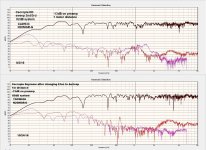 1-Cecropia_CecropiaSupreme_HDcomparison.jpg431.8 KB · Views: 151
1-Cecropia_CecropiaSupreme_HDcomparison.jpg431.8 KB · Views: 151 -
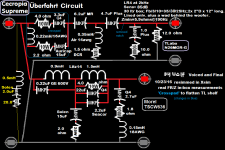 Cecropia Supreme Uberfahrt Circuit Measured&Voiced.png162.1 KB · Views: 158
Cecropia Supreme Uberfahrt Circuit Measured&Voiced.png162.1 KB · Views: 158 -
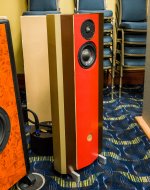 DS44681.jpg772 KB · Views: 149
DS44681.jpg772 KB · Views: 149 -
 SupremeVerify.jpg139.1 KB · Views: 147
SupremeVerify.jpg139.1 KB · Views: 147 -
 SupremeVerify_1-6th_10-24-16.jpg127.5 KB · Views: 149
SupremeVerify_1-6th_10-24-16.jpg127.5 KB · Views: 149 -
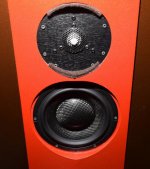 Closeup1.jpg53.4 KB · Views: 97
Closeup1.jpg53.4 KB · Views: 97 -
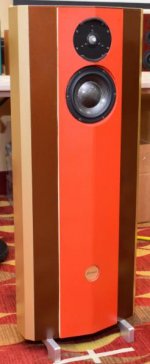 Closeup2.jpg19.3 KB · Views: 93
Closeup2.jpg19.3 KB · Views: 93
Last edited:
I guess this makes me incompetent 🙂
No, but I would also call it as learning process to produce speakers optimized to present room including acoustics, locations and personal taste/preferences. Competence could be something higher; experience developed in few decades after designing and testing different concepts to different acoustics and for people having different preferences than designer. Kinda ability to forecast what is required to produce close to best possible sound in each case.
Unfortunately reading of books, web sites and discussion forums is not enough. Studying without practical tests and prototypes of different concepts could just strength biasing to wrong direction.
Maybe chances are much better today than a decade ago because e.g. awareness of room acoustics is much higher (at least in FI). I've witnessed project which was designed and tinkered very carefully for years with lots of reading and discussion, but the result was quite sh** in many ways at least in my opinion.
Really good design.
If that was directed at me, thank you!
Wolf
I have made about 6 prototypes in a single concept over the past seven years, so in a sense I see it as one speaker.
Ask Romy the Cat how long did it took to make Macondo. Ask him if it is finished.
Ask 5th element how long it took to make his FSTNT1 and also ask him if it is finished.
Ask Juhazi how long it took to make Aino Gradient and if it is finished.
Wesayso and the Two towers.
Examples are numerous (sorry for not mentioning all of them) of loudspeakers that are among the best using particular concept. In 6 months a loudspeaker can be made. But a good loudspeaker takes much more time - not to mention the idea what to make in the first place.
EDIT: I see now that Wesayso wrote earlier in this thread. That kinda proves my point.
Ask 5th element how long it took to make his FSTNT1 and also ask him if it is finished.
Ask Juhazi how long it took to make Aino Gradient and if it is finished.
Wesayso and the Two towers.
Examples are numerous (sorry for not mentioning all of them) of loudspeakers that are among the best using particular concept. In 6 months a loudspeaker can be made. But a good loudspeaker takes much more time - not to mention the idea what to make in the first place.
EDIT: I see now that Wesayso wrote earlier in this thread. That kinda proves my point.
Last edited:
Something to bare in mind, what is the source material? Who knows what it should sound like? YouTubeTotally agree with you.! I still don't know the universal or standard speaker.
Something to bare in mind, what is the source material? Who knows what it should sound like? YouTube
Correct.! So, to say a loudspeaker needs two years or more to be developed is more passion than a necessity, even more with the technology available today.!
I was just wondering what would be the normal time it takes to design a pair of speakers?
Wrong question.

What you need to ask is not the time, but the detailed steps required.
- Its not all humbug, <snip>
I agree with you that changes do happen. The question is if those changes really mean a better sounding speaker. If so, it is hard to understand why some of the old drivers are paid like gold. Tannoy from 1950/1960, Goodman, Altec Lansing, Jansen, Western Electric, etc. I own a set of Paradigm Studio 100 V2, after the version 2, has come many more versions, 3, 4, 5. However, it is the opinion of many people the older versions are better sounding and better build than the new models. Not in all cases, the latest model is the best sounding and I tell you something, Paradigm claims there are changes for the better every time one of them hits the market.
Last edited:
Really good design.
Yes, I want to take a closer look at His design. I also like the color choices.
wolf_teeth, one question please - Are you using iron bolts in your inductor bobbins? Looks like it in your photo bucket.
Technically, designing a loudspeaker is a job of hours or a few days depending of the skills and experience of the designer and how hard he works, considering all the resources available today. A general agreement about the way it sounds may take years and you still don't get a 100% agreement it sounds good for every listener who review it. What is clear is a reference speakers for all human ears don't exist.
Last edited:
- Status
- Not open for further replies.
- Home
- Loudspeakers
- Multi-Way
- How long does it take to "design" a speakers?